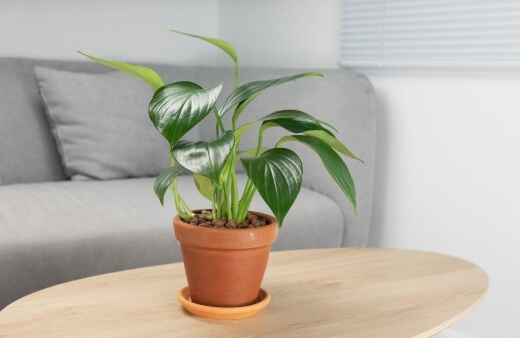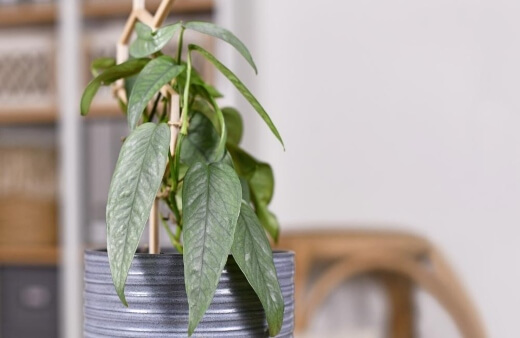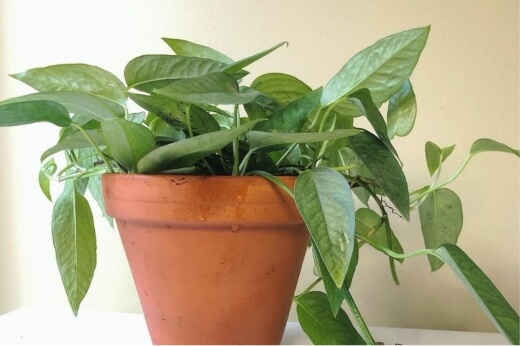The Dragon Tail Plant (Epipremnum pinnatum) is an indoor grown vine that has split leaf foilage. Juvenille plants produce leaves that are arrow or oval shaped, while the adult plants leaves are thick, leathery and split, which can be up to 200-500mm long. An adult plant can grow 1 metre tall and wide.
Adored more for its luscious glossy foliage rather than its flowers, the dragon tail plant is a true native stunner that is gaining popularity globally for its striking lavish leaves and classy appearance.
This evergreen vine resembles both pothos and monstera but features slenderer, sword or heart-shaped leaves when young that separate into wings as the plant grows, hence the dragon tail reference.
Here is everything you need to know to grow and care for the dragon tail plant in Australia.
More...
Family: | Araceae |
|---|---|
Genus: | Epipremnum |
Species: | E. pinnatum |
Common Names: | Dragon tail plant, centipede tongavine |
Location: | Indoor (outdoor in warmer climates) |
Type: | Plant, evergreen vine |
Growth: | 1 metre tall and wide |
Sun requirements: | Bright, indirect light indoors or part shade outdoors |
Foliage Colour: | Green |
Flower Colour: | Green (rarely flowers in cultivation) |
Flowering: | Summer |
Maintenance level: | Low |
Poisonous for pets: | All parts are toxic to cats, dogs and humans |
Getting to Know Dragon Tail Plant
Thanks to its aerial roots and bright green leaves, this climbing and spreading tropical vine makes for an excellent houseplant, especially when hung in baskets to allow the foliage to trail and drape downwards.
The thick, fleshy stems also add a lush presence that can compliment any setting. All parts of the plant are toxic to pets and humans so be sure to position yours appropriately.

Part of the family Araceae, these plants are native to Northern Australia and many other Indochina regions. They naturally grow as forest floor dwellers, thriving and growing best in tropical to subtropical climates, so they love warmth and humidity.
However, they are extremely adaptable and can grow almost anywhere indoors in Australia and outdoors in warmer, frost-free climate zones.
Botanically named Epipremnum pinnatum, another common name includes centipede tongavine.
Epipremnum pinnatum Growing Habits
In cultivation, they grow to about 1 metre tall and wide when used as houseplants but they can grow slightly larger in warm outdoor positions.
Due to its vining nature and striking foliage, this plant is most commonly used indoors as a potted tropical addition to existing collections.
If grown outdoors, it makes for an excellent luscious ground cover that will creep and spread along other nearby trees, plants and landscape.
This plant flowers very rarely indoors or even outdoors outside of its natural habitat.
How to Grow Dragon Tail Plant
It is best to either purchase young and healthy plants from reputable nurseries or online vendors or propagate a mature, disease-free plant using stem cuttings. Growing these evergreen vines from seed is not generally recommended.

If you choose to buy a nursery plant, be sure to transplant and establish it in your location in spring to summer to allow the plant to settle itself in warmer, less hostile conditions.
Dragon Tail Plant Propagation Using Stem Cuttings
- Establish cuttings when temperatures are warmer rather than colder.
- Using a sharp and clean pair of secateurs or scissors, cut a length of stem that has at least 2 to 3 leaves. (For a quality pair of secateurs, check out our compilation of the best secateurs available today).
- Cut about 1 to 2 centimetres below a leaf node.
- Remove only the lower leaf and place the cutting in a glass or jar filled with water with the bottom node submerged on the stem.
- Keep the water topped up as needed to keep that node covered with water constantly.
- You can expect new roots to form within about 4 to 6 weeks depending on the surrounding conditions.
- Once your cuttings roots are 10 to 12 centimetres long, you can transplant it into a fresh potting mix in a well-draining container.
Tips on Establishing a Nursery Plant
- Plants are usually grown in optimal conditions within nurseries, so you’ll need to emulate those conditions as best you can to reduce transplant shock.
- When transplanting into a new container, be sure to disturb the roots as little as possible.
- Water your potting soil before and after transplanting.
- Boost the soil by adding some fertiliser or organic compost to increase your plant's nutrient intake. This can also help in reducing shock.
- Slowly acclimatise your plant to more water and sunlight as it develops.
- Be sure to always use premium potting mixes and well-draining containers.
Best Conditions for Growing Dragon Tail Plant
Being native to tropical environments, this plant does require a similar climate and conditions to grow and thrive. Luckily, most of our endemic conditions are perfect, especially when planted indoors. Only establish outdoors in warmer, frost-free climates.

Lighting for Best Growth
Your dragon tail will thrive and grow fastest when given bright, indirect light indoors. It will be able to tolerate lower light positions inside as well but the growth rate will be stunted.
For outdoor growing, plant in a partly shaded position for the best results. For either scenario, be sure to avoid harsh, direct sun as this can quickly scorch the leaves.
To know if your plant needs more sun, you will notice that the leaves become more elongated than usual or the stems will start growing leafless altogether. Move into sunnier positions if this occurs.
Ideal Soil Conditions
For container growing, be sure to use a premium potting mix that is well-draining and enriched with organic materials. For gardens, improve beds by adding some sand or perlite to ensure good drainage and enrich your soil before planting with some organic compost or other organic matter.
Dig through and loosen the soil before planting then add a fresh layer annually during spring.
Dragon Tail Plant Care Guide
Once established, the dragon tail plant will be drought tolerant and will also be able to tolerate wet and salty soil conditions in more coastal-based locations.
But like with most cultivated plants, a little extra care always goes a long way.

Source: plantly.io
Watering Schedule
Water regularly until established. This is usually after about 12 weeks. Thereafter, water deeply as needed for growth. Be sure that your water falls out the bottom of your container and generally allow the top 3 to 5 centimetres of soil to dry before watering again.
Mulching
Mulch regularly for the first 12 weeks until your plant is established. Try to use organic mulch for the best results. Shredded bark, nut shells or coarse sand can all work great. After the initial 12 weeks, you can mulch as needed.
What Fertiliser to Use
Apply a balanced slow-release houseplant fertiliser in spring to encourage new growth.
Pruning Dragon Tail Plant
Remove any damaged or spotty leaves to promote healthy new growth. If your plant is getting a little too vigorous, you can also prune stems back to slow down the rate of spreading and climbing.
Humidity Control & Repotting
Mist leaves occasionally or group your plant with other indoor plants to increase humidity levels, your plant will appreciate it. Repotting will also be necessary for indoor-grown plants.
Repot once every 1 to 2 years into a container one size up each time.
Possible Dragon Tail Plant Pests & Diseases
These plants are very resilient overall. Outdoor grown plants tend to be less likely to suffer from any pest or disease issues whereas indoor plants are more susceptible to certain issues.
Mealybugs
A common indoor plant pest, these small white insects can normally be seen in leaf pivots or on the undersides of the leaves. They can easily be treated with neem oil or a similar insecticidal oil or spray.
Start treatment as soon as you notice them to stop them from spreading to your other plants. You can also use a water and soap mixture and wipe them off manually with a soft cloth. (Here is an excellent 100% Organic Neem Oil for Plants).
Fungus Gnats
A more severe and frustrating common pest indoors, fungus gnats are dark grey to black little flies with grey, transparent wings, long legs and long antennae. To treat a fungus gnat infestation, drench and drain your potting mix well with an eco-neem oil to eradicate young larvae that are living in your mix.
This will break their lifecycle and prevent further concern. Add some fresh potting mix only once you’ve cleared the infestation.
Root Rot
This will appear as browning leaves, black to brownish roots and perhaps a musty odour. Stems may also begin to look wilted and wet.
Overwatering is the likely cause so be sure to reduce watering even further to allow the top 3 to 5 centimetres of mix to dry out completely before watering again.
Try to also avoid letting your plant sit in a filled saucer or cover pot whenever possible.
Dragon Tail Plant Frequently Asked Questions

Source: myhomenature.com
Why are my dragon tail plant leaves curling?
This is most likely due to low humidity or prolonged exposure to heat and direct sun. Be sure to mist regularly and position your plant with bright but indirect light.
Is a dragon tail plant rare?
It is one of the rarer species of flowering plants in the family of Araceae. It is native to French Polynesia but is now becoming more widely distributed and cultivated in warmer regions across the globe.
Why are my dragon plant leaves drooping?
This should indicate that your plant is either underwatered or overwatered. Be sure to stick to a consistent watering routine so you know which situation may apply to your plant and then adjust your watering accordingly.
Interested in growing a very close relative that is one of the most cherished and widely grown houseplants of its family? Be sure to check out our full guide to growing and caring for Devil’s Ivy below for more information:

Dazzle and Drape Your Spaces with the Lavish Dragon Tail Plant
A superb and classy native addition to your houseplant collection, the dragon tail plant can easily impress with its cascading fleshy stems, unique glossy-green leaves and its tropical presence. It can also make for excellent lush ground cover in gardens with warmer conditions.
As this evergreen vine continues to gather popularity, so does its ability to seamlessly integrate itself into any setting in the house or garden, whether modern or more relaxed.
Spruce up your living spaces with the dragon tail plant, a very special member of its genus.
Published on July 16, 2022 by Nathan Schwartz
Last Updated on February 22, 2024




